Future of Energy: Solutions Through Cooperation
advertisement
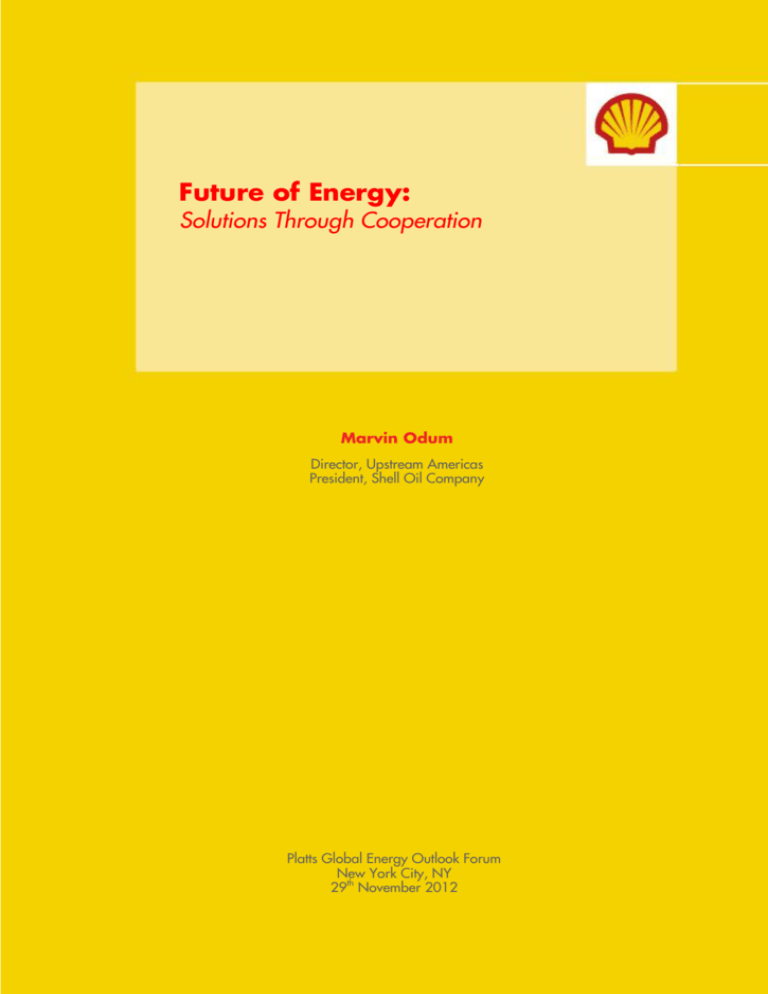
Future of Energy: Solutions Through Cooperation Marvin Odum Director, Upstream Americas President, Shell Oil Company Platts Global Energy Outlook Forum New York City, NY 29th November 2012 Marvin Odum: Future of Energy: Solutions Through Cooperation Marvin E. Odum is President of Shell Oil Company and Director Upstream of Royal Dutch Shell’s subsidiary companies in the Americas. Odum directs a broad portfolio, from traditional oil and gas development to emerging technologies in a wide range of areas, including heavy oil, onshore gas, light tight oil, deepwater, wind and biofuels. Odum is a member of the Council on Foreign Relations and holds positions of board leadership and participation in the Business Roundtable and the American Petroleum Institute, and is on the executive committee of the World Business Council for Sustainable Development. In addition, he is a member of the Dean’s Council of the John F. Kennedy School of Government at Harvard University and the Advisory Board of the Cockrell School of Engineering at The University of Texas at Austin. He also serves on the University Cancer Foundation Board of Visitors for MD Anderson Cancer Center Odum earned a bachelor’s degree in mechanical engineering from The University of Texas at Austin and a master’s degree in business administration from the University of Houston. He began his Shell career as an engineer in 1982, and has since served in a number of management positions of increasing responsibility in both technical and commercial aspects of energy. His current role involves engaging with public, private, media and non-governmental leaders on a wide range of energy policy issues. He is charged with establishing and advocating innovative, industry-leading solutions to the challenge of securing safe, secure and sustainable energy sources. 2 Marvin Odum: Future of Energy: Solutions Through Cooperation Introduction Good afternoon. part because of the same technologies that have expanded our production of gas) would exceed Saudi Arabia as the world’s leading oil producer by 2020. It’s always tempting, particularly in front of audiences like this one, to open with a reference to change…how we are living in revolutionary times…how we’re on the brink of new challenges and opportunities. This, of course, has the potential to radically change the geopolitical calculations in capitals around the world. It’s an easy way to get a room full of people who maybe are a little drowsy after lunch to perk up, hoping to hear something new. A Four Pillar Strategy For Gas If I was going to play the “how the world is changing” card today I would go on to talk about the revolution in natural gas. That revolution is real. America suddenly has a 100 year supply of natural gas “in the bank” and the world has 250 years – thanks in part to breakthroughs in the technology that unlock hydrocarbons from tight rock and shale. These new resources are not just a source of energy but a source of cleaner, more affordable, more secure energy than any other of a similar scale. The gas revolution is a creator of new jobs...a catalyst for a renaissance in American manufacturing…a bridge to future renewable…and (with carbon capture and storage) a destination fuel for an increasingly carbon-constrained economy. At the same time the boom in North American gas is re-drawing the geopolitical map of the world as North America shifts increasingly towards selfsupply and even energy exports. The International Energy Agency (IEA) this month caught a lot of people’s attention by predicting that the US (in 3 Certainly it is influencing investment strategies in companies like mine. Shell is already the world’s leader in Liquefied Natural Gas (LNG). Shell ventures delivered more than thirty percent of all the world’s LNG volumes in 2011. We have eight LNG projects in operation today with three new projects under construction globally, served by 52 LNG tankers and delivering clean-burning energy to markets around the world. Our integrated gas earnings have more than tripled in the last five years, and as demand for natural gas increases some sixty percent by 2030 we see opportunities to invest more than $20 billion in this space over the next three years. In the United States specifically we’re exploring four pillars for our gas strategy. The first is to channel gas into the chemicals industry where it can support the expansion of domestic manufacturing. The second is to convert gas into liquid petroleum products like synthetic diesel and base oil. We’re doing that already in Qatar, with a proprietary “gas-toliquid” – or GTL – technology, which by itself was a close to $20 billion investment. We are evaluating an opportunity to do something similar along the US Gulf Coast. Our integrated gas earnings have more than tripled in the last five years, and as demand for natural gas increases some sixty percent by 2030 we see opportunities to invest more than $20 billion in this space over the next three years. Marvin Odum: Future of Energy: Solutions Through Cooperation The third is to open up more opportunity to use natural gas in transport, something I’ll come back to in a few minutes. And finally, we’re looking at opening a channel for LNG exports from the US to energy-hungry markets. These are all big changes. They create important new options - not just for the oil and gas industry but also for policy makers and manufacturers. But I will come back to where I started and say that change is no longer news. We’re constantly waking up to something new in our industry: some new technical breakthrough…some new peak or trough in the economic cycle…some new geopolitical eruption in the world…a new social or environmental concern that needs to be tackled. So I’d like to shift gears slightly and suggest what is “unchanging” about all that change. What are some of the constants underpinning this natural gas revolution? And where is the trajectory of those constants likely to lead? Three obvious themes emerge, not only from the recent past, but also the predictable future. Those themes give us some pretty good clues as to how we need to think about the next half century of our business. The first consistent theme (and no surprise) is the world’s increasing appetite for energy. Meeting The Needs of 9 Billion People Let’s not forget that our business is not just about molecules and money, but about people. Roughly a billion people in developing parts of the world are just 4 now entering the market for the cars, washing machines, refrigerators, and computers that they see in the developed world. Every day the world is home to nearly 200,000 more people who are consuming more products…and expecting more physical and social mobility…and living in more dense urban centers. By 2050 our children will share this planet with 9 billion people. That means the world will be adding the equivalent of a city of one million people, say the size of Rochester, NY, every week for the next 30 years. Every one of those cities, every one of those people, will need energy to survive and to thrive. That means the global demand for energy could grow dramatically by the middle of this century. And that leads directly to a second consistent theme, which is that we’re going to have to work harder and innovate more to keep energy supplies growing as fast as energy demand. It’s true that the world’s total supply of energy has never failed to meet demand…not yet, anyway. And it’s true that technology breakthroughs have resulted in such a short-term glut of natural gas in this country that fears about supply seem irrelevant. Even as we speak natural gas prices are coming through a significant trough and some companies that piled-in are now scrambling to retrench. But it’s also true that demand growth over the medium- to long-term will continue to force us to greater lengths, greater depths, greater temperatures, greater pressures, and greater imagination to make sure a shortfall in energy supply doesn’t happen. The world will be adding the equivalent of a city of one million people, say the size of Rochester, NY, every week for the next 30 years. Marvin Odum: Future of Energy: Solutions Through Cooperation Even if energy efficiencies – spurred by innovation and competition – reduce growth by, say, 20 percent, and even if ordinary rates of supply growth (including the current revolution in natural gas) boosts supply by 50 percent…we could still face a gap between supply and demand equivalent to the size of the entire industry in the year 2000. business that help customers use less fuel and emit less greenhouse gasses. And “ordinary” rates of growth don’t necessarily reckon with post-recession volatility, the European banking crisis, geopolitical upheaval, regulatory uncertainty, and changing perceptions of risk. All of which make “ordinary” unlikely. To the careful observer…to anyone thinking about what the world’s energy system is going to look like by the middle of this century…at the very least to anyone plotting a blueprint to competitiveness in this industry…I think these three themes send a very loud signal. And that’s even before allowing for the third consistent theme in our industry, which is how much less society is willing to accept the side effects of energy. Energy is the oxygen of human existence and yet producing it causes pressure on environments and social fabric in every corner of the globe. Using it causes even more. We owe it to our shareholders and stakeholders alike to keep finding new ways to relieve or eliminate those pressures. The Business of Energy For Shell, those ways take many different forms. Everything from investing in a Carbon Capture and Storage (CCS) project in Alberta that will capture and safely store, deep underground, more than a million tons of carbon from our oil sands operations every year…to advocating for a global market framework that puts a reasonable price on carbon emissions…to developing and implementing detailed principles for how we will safely and responsibly drill for gas…to hiring 150 wildlife observers in our Alaska exploration program to watch out for fish and mammals that may be affected by our presence…to developing fuels and lubricants in our downstream 5 The list goes on. These things are important to our license to operate today. They are even more important to our competitive edge tomorrow. That signal is this: more than ever before we will need to think about the business of energy as only one part of a complex global system of interconnected challenges. And succeeding in our business will mean coming up with integrated and innovative solutions and partners to tackle those challenges. Business And Government – Regaining Public Trust The most obvious collaboration is between business, government and society. In too many ways this critical relationship is broken. Public trust in the motives and values of “Big Business” has been battered for much of the last two decades. For the last ten years the Edelman Public Relations Agency has surveyed citizens in 25 countries for its annual “Trust Barometer.” According to this year’s barometer, trust in business has rarely been lower. And it shouldn’t make us feel any better that trust in government is lower yet. Public trust in the motives and values of “Big Business” has been battered for much of the last two decades. Marvin Odum: Future of Energy: Solutions Through Cooperation The presidential campaign that ended this month exposed at least the perception of an angry divide between Americans who want this country to unshackle economic opportunity for individuals and businesses on one hand and those who want this country to protect the common good on the other. But there doesn’t have to be a divide. I can point to real examples where business and government work together to secure both the opportunity and the protection. One that may surprise you is related to new exploration for energy offshore Alaska. There is a great deal of evidence to suggest that massive resources of energy lie under the waters off the North Slope of Alaska. And those resources could be critical to the nation’s economy as well as its long-term security. But developing those resources comes with significant financial, social, and environmental risks. So how do you balance those rewards and risks against each other? Well, you can’t. At least not effectively unless government, society and business work with one another to define expectations, agree on operational standards, and collaborate on solutions. In this case the past two Administrations looked hard at what Shell was prepared to do in Alaska. They did their due diligence. To enable this they created an unusual interagency group to “clear a path” through the aggravating thicket of Federal regulatory bureaucracy. At the same time, we at Shell worked day in and day out with federal officials, state government, and local communities to create one of the most comprehensive and sophisticated exploration plans ever devised. Another area where we agree with the Administration is that there is a way and a need to establish a faster, more efficient, more predictable and even more thorough permitting process for our industry. And we are working together on this. But getting there means that government needs to know it can trust industry to operate safely, to be committed to reducing the impact of operations, and to respect public interests along with business interests. Industry needs to know it can trust government not to impose arbitrary burdens and delays, not to vilify business, and to set clear and consistent policies that can inform our long-term investments. And society needs to know it can trust both business and government to do their jobs in a way that soberly balances risks and rewards. It can be done. Finding Solutions Through Cooperation I believe that this Administration sees these resources as critical and strategic to the nation and part of their “all of the above” energy strategy. Innovative and integrated solutions and partners don’t just apply to companies and government. We’re also cultivating valuable new collaborations between producers and consumers of energy. I also like to think the Administration sees Shell as a capable partner in developing this national resource. Take, for example, what we’re calling Gas-to-Transport initiatives (that’s natural gas). 6 There is a great deal of evidence to suggest that massive resources of energy lie under the waters off the North Slope of Alaska. And those resources could be critical to the nation’s economy as well as its long-term security. Marvin Odum: Future of Energy: Solutions Through Cooperation From 2012, we’re making LNG available as a transport fuel for specially adapted trucks on a route that runs from Northern Alberta, Canada to Vancouver. This can replace the diesel that previously powered these trucks. We also recently signed a memorandum of understanding with TravelCenters of America to sell LNG to heavy-duty road transport customers in the US at about 100 sites nationwide. We have a joint cooperation agreement with Wartsila North America to accelerate the use of larger marine engines using lower-cost, lower-emissions LNG and a similar agreement with GE for railroad locomotives. In a separate initiative we’re working with suppliers, state governments, business customers, and our own chemicals business on the possibility of an ethylene cracker in Appalachia that would convert natural gas into jobs, fuel and raw materials that could form the basis of renewed manufacturing in that region. Were working with companies like Coca Cola, JP Morgan Chase, Nike, Suncor, UPS, and Wal Mart on a project relating to the Future of Fuel to aid producers and consumers of transport fuels in analyzing the wide range of fuel choices they face. Looking even further over the horizon, we’re working with companies like IBM and Dow on initiatives related to the “interconnection” of the three biggest stressors facing the planet over the next few decades: water, food, and energy what many are calling a “stress nexus.” We see a vital need to manage the demand and the supply of those 7 resources more intelligently, from reducing demand through much more efficient consumption, to smarter employment of natural eco-system services. The solutions will require not only understanding how the use of those resources affect each other, but also working together across sectors to develop and implement solutions on local, national and global levels. Conclusion So yes, the revolution in our industry today is mainly about new, unconventional resources, like shale gas. This year’s news is about how companies like Shell and governments around the world will manage new investment opportunities, new patterns of trade, and new ways of capturing value. But the story won’t stop there. The three unaltered themes of change will continue well into the middle of this century. The future for the leaders of our industry is going to demand thinking more broadly about the purpose of our business about the nexus of energy with other critical resources, and about new and innovative collaborations for solving critical societal challenges. My expectation is that next year at this conference we will be talking more about integrated solutions to some of those challenges. Thank you. ### From 2012, we’re making LNG available as a transport fuel for specially adapted trucks on a route that runs from Northern Alberta, Canada to Vancouver. This can replace the diesel that previously powered these trucks. Marvin Odum: Future of Energy: Solutions Through Cooperation RECENT SPEECHES BY SHELL’S SENIOR LEADERSHIP Europe’s stake in the Canadian energy supply revolution, Simon Henry Facing up to our global challenges in a volatile, uncertain world, Jorma Ollila ET – Extraterritoriality – Alien or Friend, Peter Rees Investment, inoovation & imagination: The keys to Canadian-American leadership in the global energy challenge, Marvin Odum Natural gas: innovation for a sustainable future and global growth, Peter Voser Global legal challenges facing the petro-chemical industry, Peter J. Rees Energy demand, supply and downstream infrastructure challenge, Mark Williams Water, energy and the resource consumption puzzle: It’s time for solutions, Peter Voser The natural gas revolution: a secure, abundant force for good, Peter Voser Growing global energy demand: a defining moment for Louisiana, Marvin Odum Shell and corporate tax, Simon Henry Meeting the needs of 9 billion people, Marvin Odum Qatar’s role in the energy landscape of the future, Peter Voser New Frontier: engineers and the global energy challenge, Malcolm Brinded For information about Shell, including downloadable versions of these speeches and other publications, please visit www.shell.com. © Shell International Limited (SI), 2012 Permission should be sought from SI before any part of this publication is reproduced, stored in a retrieval system, or transmitted by any other means. Agreement will normally be given, provided that the source is acknowledged. The companies in which Royal Dutch Shell plc directly and indirectly owns investments are separate entities. In this publication the expressions “Shell”, “Group” and “Shell Group” are sometimes used for convenience where references are made to Group companies in general. Likewise, the words “we”, “us” and “our” are also used to refer to Group companies in general or those who work for them. These expressions are also used where there is no purpose in identifying specific companies. 8
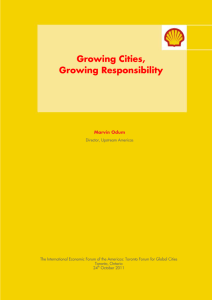


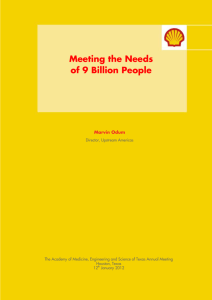
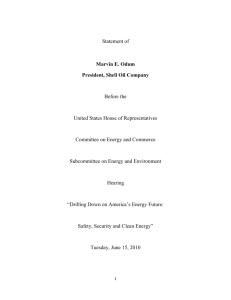
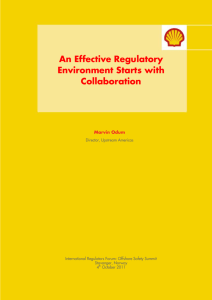


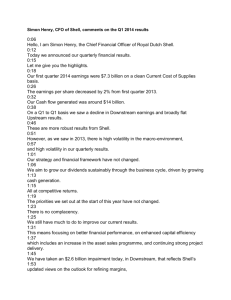
![[#IDENTITYCONNECTORS-299] SHELL scripting](http://s3.studylib.net/store/data/007586759_2-6776383e22ea2e271e255b7e6702f077-300x300.png)